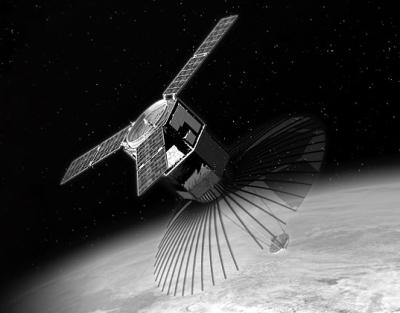Tue, Jun 04, 2013
Functional Testing On Northrop Grumman-Built Spacecraft Completed
A Northrop Grumman Corporation-led team recently completed the third gate review of its first Modular Space Vehicle (MSV) bus assembly, integration and test, marking completion of functional testing. The team will conduct comprehensive "day in the life" testing next for the Operationally Responsive Space-2 (ORS-2) bus, leading to hardware acceptance by the Air Force's ORS program office. To mark this occasion, the ORS office held an open house on May 9 at Applied Technology Associates in Albuquerque, NM, where hardware integration and test were performed.

Northrop Grumman's MSV spacecraft design is the first to implement a modular, rapidly reconfigurable architecture using open standards developed by an industry consortium in conjunction with the Air Force Research Laboratory and the Air Force's ORS Office at Kirtland Air Force Base, NM. "Completing these test processes will show that our design meets ORS' program objective requirements and moves the government closer to the launch of this first-of-its-kind vehicle that could revolutionize the way spacecraft are built," said Doug Young, vice president, Missile Defense and Advanced Missions, Northrop Grumman Aerospace Systems. "We are bringing network avionics technology to spaceflight and giving the nation an affordable option to respond to rapidly changing, multi-mission needs."
"The government's investment in the past two-and-a-half years has developed a scalable, open architecture capability that allows bus components and payload modules to plug into a central spacecraft network using standardized technology, much like the way new hardware can be plugged into computers via USB ports," said Phil Katz, Northrop Grumman's MSV program manager.
Northrop Grumman is performing MSV-related study and hardware development under a five-year contract awarded in November 2010 by NASA's Ames Research Center, Moffett Field, CA, supporting the Air Force's Operationally Responsive Space Office. Northrop Grumman has successfully used this rapid development approach before, building and launching the award-winning Lunar CRater Observation and Sensing Satellite for NASA Ames in just 27 months.
(Modular Space Vehicle image provided by Northrop Grumman)
More News
Pilot Also Reported That Due To A Fuel Leak, The Auxiliary Fuel Tanks Were Not Used On June 4, 2025, at 13:41 eastern daylight time, a Piper PA-23, N2109P, was substantially damage>[...]
From 2023 (YouTube Edition): Reflections on War’s Collective Lessons and Cyclical Nature The exigencies of war ought be colorblind. Inane social-constructs the likes of racis>[...]
Pilot Reported That He Was Unfamiliar With The Single Seat Amateur-Built Airplane And His Intent Was To Perform High-Speed Taxi Testing Analysis: The pilot reported that he was unf>[...]
From 2023 (YouTube Edition): First Kits to Ship October 2023 Having formerly resurrected the storied shape of the Ryan ST—in effigy, anyway—Montrose, Colorado-based Tim>[...]
Performance-Based Navigation (PBN) [ICAO] Area navigation based on performance requirements for aircraft operating along an ATS route, on an instrument approach procedure or in a d>[...]
 NTSB Prelim: Piper PA-23
NTSB Prelim: Piper PA-23 Classic Aero-TV: One Mans Vietnam
Classic Aero-TV: One Mans Vietnam NTSB Final Report: Capella Aircraft Corp FW1C50
NTSB Final Report: Capella Aircraft Corp FW1C50 Classic Aero-TV: Timber Tiger Touts Curtiss Jenny Replicas
Classic Aero-TV: Timber Tiger Touts Curtiss Jenny Replicas ANN's Daily Aero-Term (07.04.25): Performance-Based Navigation (PBN) [ICAO]
ANN's Daily Aero-Term (07.04.25): Performance-Based Navigation (PBN) [ICAO]



